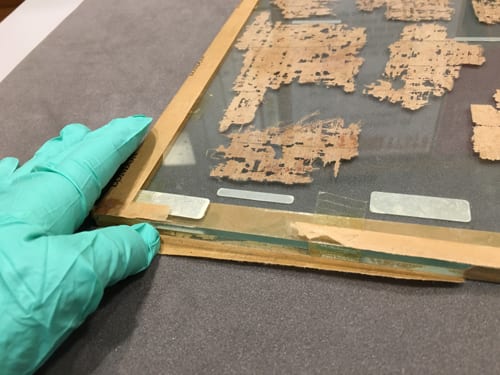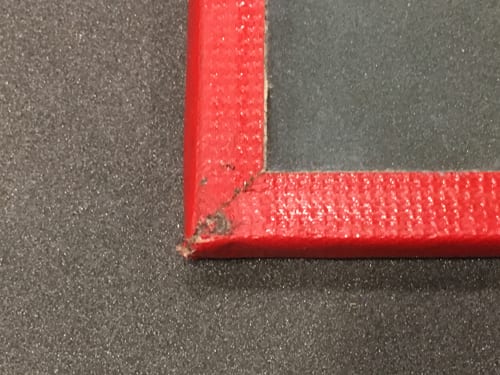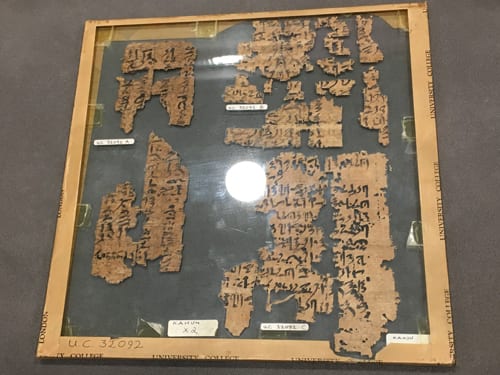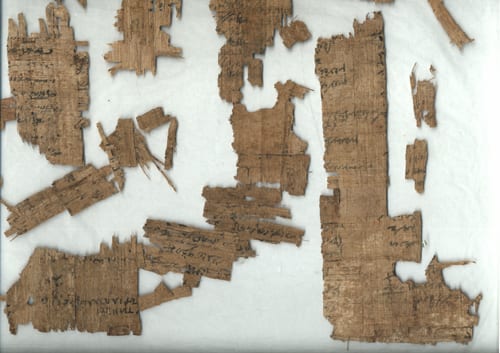Repairing our Inner Seals
By tcrnlmb, on 3 October 2017
Firstly, I would like to apologise to those readers who think that this blog will be about the type of seals who like to eat fish. It is, in fact, about the seal created by a layer of tape, which protects conserved papyri from external forces. I’m not really sorry, however, because this blog is all about the importance and means by which we protect and save objects, some nearly 4000 years old, for both the present and the future.
As accessibility is the main aim of the Papyrus for the People Project, we knew that we would need to make sure that our collection was able to handle, well, handling. Conservation is key, so from February to April 2017, we conducted a conservation survey of the collection.
Most of the papyri in the museum has been conserved by being sandwiched between two sheets of glass, which have then had tape applied around the edges to seal it. This structure that the papyrus sits in is called a frame and is the most common way to conserve papyri. However, when the tape becomes frayed, or is ripped off completely, the inner seal is broken and this means that the papyrus could potentially be exposed to pests, humidity, water-damage and dust.
Therefore, as we pulled out each individual frame from the cupboard they are stored in, we checked: the location, its measurements, the condition of the tape, the condition of the glass, the safety of the papyrus within and the stability of any inks or pigments.
The most common conservation issues included:
– Sticky tape corners.
– Ripped and torn tapes around the edges of the frames.
– Broken or cracked glass.
– Old Sellotape, often under another type of tape, which is now stained and degrading.
– Papyrus which has not been mounted properly and has moved within the glass.
This information was put into a spreadsheet, which allowed us to collate and rank the data; prioritising those items requiring the most difficult or time-consuming conservation treatment. This list was then sent to our conservator, Vania Assis, who is currently repairing them.
But I couldn’t bear to disappoint anyone, so I’ll here’s a ‘real’ seal as well.
The Designation Scheme recognises, celebrates and champions significant collections of national and international importance held outside national museums. Awards of Designated status are made by an independent expert panel, based on the collection’s quality and significance.
The 2016-18 round of the Designation Development Fund is investing £1,330,849 to support projects that ensure the long-term sustainability of Designated museum collections.
The Designation Development Fund recognises the importance of excellent collections and provides funding for projects that ensure their long-term sustainability, maximise their public value and encourage the sharing of best practice across the sector. In this round, we will focus on opportunities around research and understanding of Designated collections.
***Arts Council England champions, develops and invests in artistic and cultural experiences that enrich people’s lives. We support a range of activities across the arts, museums and libraries – from theatre to digital art, reading to dance, music to literature, and crafts to collections. Great art and culture inspires us, brings us together and teaches us about ourselves and the world around us. In short, it makes life better. Between 2015 and 2018, we plan to invest £1.1 billion of public money from government and an estimated £700 million from the National Lottery to help create these experiences for as many people as possible across the country. http://www.artscouncil.org.uk/
Louise Bascombe is the Curatorial Assistant working on the Papyrus for the People Project at the Petrie Museum of Egyptian Archaeology.
 Close
Close








